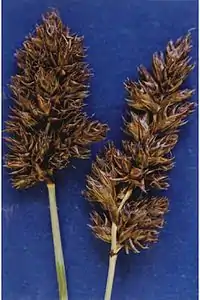Carex simulata
Carex simulata is a species of sedge known by the common name analogue sedge.
| Carex simulata | |
|---|---|
 | |
| Scientific classification | |
| Kingdom: | |
| (unranked): | |
| (unranked): | Monocots |
| (unranked): | |
| Order: | |
| Family: | |
| Genus: | |
| Species: | C. simulata |
| Binomial name | |
| Carex simulata | |
Distribution
This sedge is native to the western United States and western Canada, where it grows in many types of wet habitat, from mountain meadows to ditches, often in alkaline conditions.
Description
Carex simulata produces sharply triangular stems up to 80 centimeters tall from a long, coarse, dark brown rhizome. The inflorescence is dense and rounded to open and long, containing several flower spikes.
The plant is generally dioecious, with individual plants bearing male or female flowers, but not both. The male, staminate inflorescence is usually longer and more narrow than the oval-shaped female, pistillate spike. Female flowers bear fruits which are coated in dark brown, shiny, pointed perigynia.